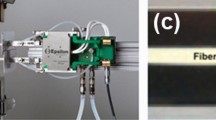Abstract
The hole-drilling method is one of the most well-known methods for measuring residual stresses. To identify unknown plane stresses in a specimen, a circular hole is first drilled in the infinite plate under plane stress, then the strains resulting from the hole drilling is measured. The strains may be acquired from interpreting the Moiré signature around the hole. In crossed grating Moiré interferometry, the horizontal and vertical displacement fields (u and v) can be obtained to determinate two strain fields and one shearing strain field. In this paper, by means of Moiré interferometry and three directions grating (grating rosette) developed by the authors, three displacement fields (u, v and s) are obtained to acquire three strain fields. As a practical application, the hole–drilling method is adopted to measure the relief strains for aluminum and fiber reinforced composite. It is a step by step method; in each step a single laminate or equivalent depth is drilled to find some relationships between the drilling depth and the residual strains relieved in the fiber reinforced composite materials.
Similar content being viewed by others
References
ASTM. ASTM E837-95: Standard test method for determining residual stresses by the Hole-Drilling Strain-Gage Method. Annual Book of Standards (1998)
Montay G., Cherouat A., Garnier C., Lu J.: Determining residual stress in spherical components: a new application of the hole-drilling method. J. Test. Eval. 32(1), 1–7 (2004)
Shankar K., Xie H.M., Wei R.Y., Anand A., Chai G.B.: A study on residual stresses in polymer composites using moire interferometry. Adv. Compos. Mater. 13(3/4), 237–254 (2004)
Cárdenas-García, J.F., Preidikman, S.: Solution of the Moiré hole drilling method using a finite-element-method-based approach. Int. J. Solids Struct. (43), 6751–6766 (2006)
Ya, M., Miao, H., Zhang, X., et al.: Determination of residual stress by use of phase shifting Moiré interferometry and hole-drilling method. Opt. Lasers Eng. (44), 68–79 (2006)
Pisarev, V.S., Bondarenko, M.M., Chernov, A.V., et al.: General approach to residual stresses determination in thin-walled structures by combining the hole drilling method and reflection hologram interferometry. Int. J. Mech. Sci. (47), 1350–1376 (2005)
Viottia, M.R., Kaufmann, G.H.: Accuracy and sensitivity of a hole drilling and digital speckle pattern interferometry combined technique to measure residual stresses. Opt. Lasers Eng. (41), 297–305 (2004)
Zhu, W.U., Guillaume, M., Lu, J.: High sensitivity Moiré interferometry and incremental hole-drilling method for residual stress measurement. C. R. Acad. Sci. Paris, t. 329, Série II b, 585–593 (2001)
Post D., Han B., Ifju P.: High Sensitivity Moiré. Springer, New York (1994)
Timoshenko S.P.: Theory of Elasticity. McGraw-Hill Book Company, Auckland (1991)
Author information
Authors and Affiliations
Corresponding author
Additional information
The project was supported by the National Natural Science Foundation of China (10772117, 10572089).
Rights and permissions
About this article
Cite this article
Chen, J., Peng, Y. & Zhao, S. Hole-drilling method using grating rosette and Moiré interferometry. Acta Mech Sin 25, 389–394 (2009). https://doi.org/10.1007/s10409-008-0224-4
Received:
Revised:
Accepted:
Published:
Issue Date:
DOI: https://doi.org/10.1007/s10409-008-0224-4




